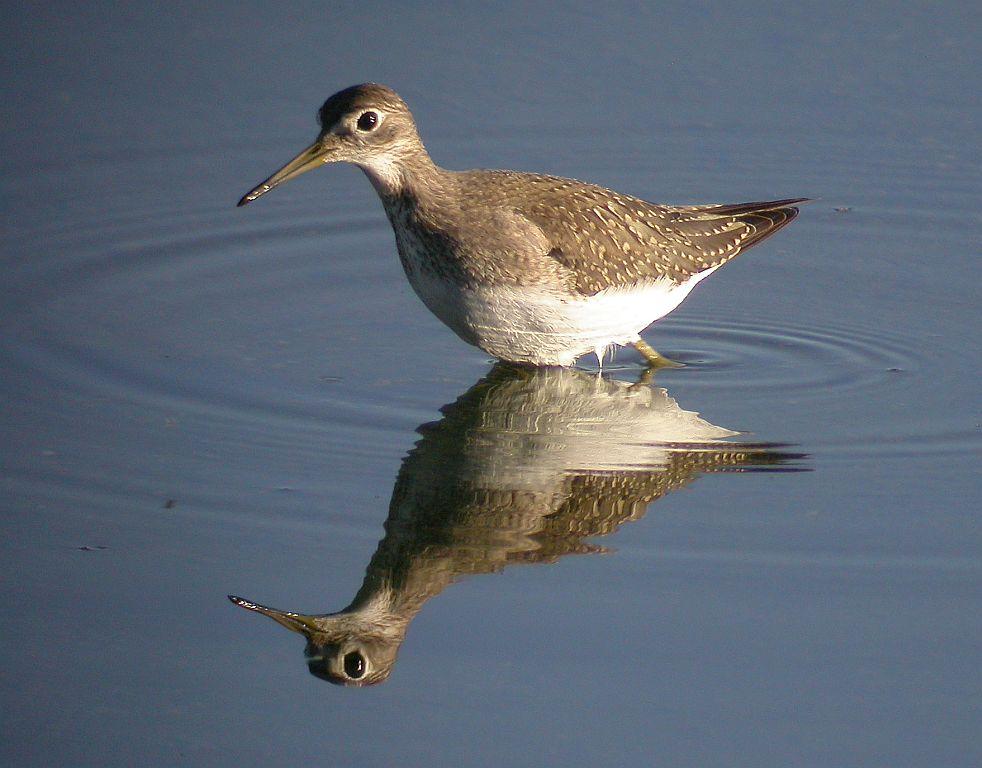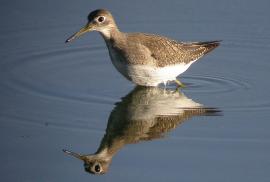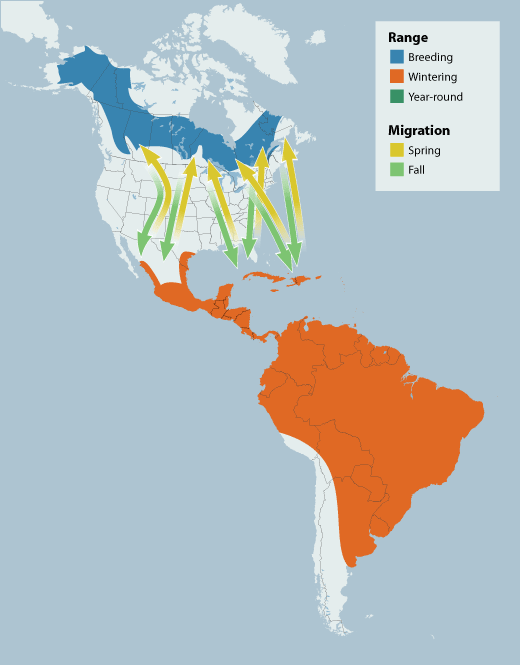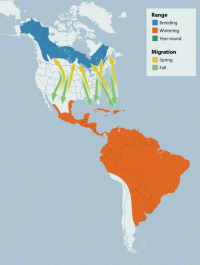Guide to Boreal Birds
This is an in-depth boreal species profile.
What is this?
This species is one of more than 30 birds selected for in-depth profiles. Find out why and see all selected boreal birds »
Overview
The well-named Solitary Sandpiper usually migrates alone rather than in flocks. It feeds along the margin of a wooded pond or stream and, in the West, along the edges of irrigation canals and small ponds, especially where cattle are watered. When disturbed, it bobs its head and flies up, uttering its ringing note call. Its habit of nesting in the abandoned nests of other birds is unique among North American shorebirds, which generally nest on the ground.
Unlike most sandpipers, which migrate and winter in flocks, this species is aggressive and territorial year-round. This fact has made studies of its movement patterns difficult compared to those of other shorebirds. This, combined with its remote breeding range and inaccessible nesting habitat, make the Solitary Sandpiper one of our least-known shorebirds. In fact, its nest was not discovered until 1903, 90 years after the bird was described.
Description
8 1/2" (22 cm). A small dark sandpiper with dark olive legs, speckled upperparts, white tail barred with black, and prominent eye ring. Flight is swallow-like. No white wing stripe, as seen in Spotted Sandpiper.
Voice
A high-pitched peet-weet or peet-weet-weet, more shrill than call of Spotted Sandpiper.
Nesting
4 pale green or buff eggs, thickly spotted with gray and brown, in deserted tree nests of thrushes, jays, or blackbirds.
Habitat
The Solitary Sandpiper nests in muskeg bogs in areas of coniferous, particularly spruce, forest near ponds and lakes. On migration and in winter it is almost strictly an inland bird, favoring muddy margins of lakes, ponds, streams, and puddles. It uses forested ponds and lakes, often very high in elevation. Such habitats are seldom exploited by other shorebirds. In winter it is found on small pools and rivers, marshes, rice paddies, roadside ponds, sandy river beaches, and muddy lake margins, and sometimes in brackish habitats on the coast.
Range/Migration
The Solitary Sandpiper winters across a broad area from the extreme southern U.S. south to Central America, the Caribbean, and tropical South America, reaching central Argentina on the east side. Most migrate east of the Rockies, some following inland routes, some coastal, and some, especially in fall, apparently crossing the Atlantic on a direct route to and from South America. Peak passage dates in the U.S. are from late April to mid-May and from late July to early August. Unlike other shorebirds, it never migrates in large flocks.
Breeding
Ninety percent of the global population of Solitary Sandpiper breeds in the boreal forest of North America, from western Alaska to Labrador and south to the northern shores of the Great Lakes. It nests in the lower 48 only in extreme northeastern Minnesota. Alone among North American sandpipers, and one of only two sandpipers in the world to do so, the Solitary Sandpiper nests in abandoned songbird nests in trees. Nests of robins, blackbirds, kingbirds, waxwings, and jays are used most often. These nests may be as much as 12 meters (40 ft) off the ground. Pairs apparently form soon after arrival on the breeding grounds in May following a courtship display by the male in which he rises slowly a short distance into the air with quivering wings and spread tail while twittering. Three to five, usually four, eggs are laid; both sexes incubate, probably for slightly over three weeks. The precocial young presumably jump to the ground shortly after hatching and begin following one or both parents. There is only one brood attempt per year. Nothing is known about the post-fledging stage.
Diet/Feeding Behavior
This species is primarily an insectivore, supplementing its diet with small crustaceans, mollusks, spiders, worms, fish, frogs, and tadpoles. Mosquito larvae and young midges appear to be the primary prey but virtually any animal small enough will be eaten opportunistically. It has been observed extracting snails from their shells. It rarely probes, preferring instead to snatch prey from the surface. It often stirs up food by shaking a foot in the substrate and catching animals that are roused and attempt to flee; this behavior also has evolved in groups as diverse as gulls, egrets, and thrushes.
References
Johnsgard, P.A. 1981. The plovers, sandpipers, and snipes of the world. Univ. of Nebraska Press, Lincoln.
Moskoff, W. 1995. Solitary Sandpiper (Tringa solitaria). In The Birds of North America, No. 156 (A. Poole and F. Gill, Eds.). Philadelphia: The Academy of Natural Sciences; Washington, D.C.: The American Ornithologists' Union.
National Audubon Society. 2002. The Christmas Bird Count Historical Results [Online]. http://www.audubon.org/bird/cbc.
Oring, L.W. 1973. Solitary Sandpiper early reproductive behavior. Auk 90:652-663.
Sauer, J. R., J. E. Hines, and J. Fallon. 2003. The North American Breeding Bird Survey, Results and Analysis 1966-2002, Version 2003.1, USGS Patuxent Wildlife Research Center, Laurel, MD.
Credits
Birding content provided by National Wildlife Federation/eNature, with support from Ducks Unlimited/The Pew Charitable Trusts.





